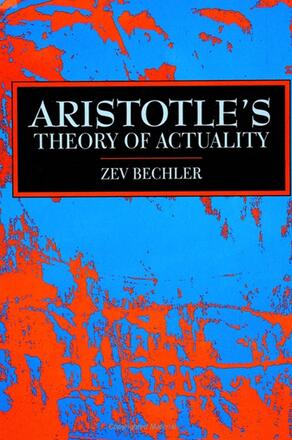Acknowledgments
Introduction: The Idea of Anti-Informationism
1. Tradition: Forms into Forces
2. Nonseparability and its Consequences
3. A Note on the Translations
Chapter One: Aristotle's Explanation of Natural Motion
1.1. The Natural Motion Puzzle and the Two Potentialities
1.1.1. Soul as First Actuality
1.1.2. The Definition of Motion and the Aspects of the Potential
1.1.3. The Two Potentials
1.1.4. Genuine Potentiality Is One with Actuality
1.1.5. Consistency-Potentials Are Noneffectual and Nonreal
1.1.6. A Role for Consistency-Potentials: Dispute with the Megarians
1.1.7. Plato's Forms and the Nature of Consistency-Potential
1.1.8. Aristotle's Principle of the Priority of the Actual
1.2. The Explanation of Natural Motion
1.2.1. Is everything moved by another in Aristotle's physics?
1.2.2. The Official Interpretation and the Energizer Theory
1.2.3. The Natural Motion of Living Creatures is Uncaused Motion
1.2.4. Is "nature" the mover in the natural motion of the elements?
1.2.5. How can potentiality be the mover in natural motion?
1.2.6. Practical Syllogism and the Necessity of Action
1.2.7. Desire and Motion
1.2.8. The Mover in Natural Motion Is a Logical Mover
1.3. Logical Causality and Teleology
1.3.1. Form and End Are Logical Causes
1.3.2. Efficient Causes and Logical Causality
1.3.3. Is Causal Necessity Really Different from Teleological Necessity?
1.3.4. Hypothetical and Categorical Necessities are the Same
1.3.5. Means and Ends Are Strictly Convertible
1.3.6. Aristotle's Teleology "Strictly Speaking"
Chapter Two: Logical Causality and Priority of the Actual: Consequences and Illustrations
2.1. Coincidence, Relationality and the Ontology of Potentiality
2.1.1. Coincidentality Entails Non-Causality
2.1.2. Why is the coincidental necessarily causeless?
2.1.3. The Nullity of the Coincidental
2.1.4. Clustering, Instantaneity and the Relativity of the Coincidental
2.1.5. The Identity of the Relative and the Coincidental
2.1.6. Lack and the Coincidental
2.1.7. The Potentiality Connection
2.2. The First Mover Fiasco
2.2.1. The Ontology of Met 12
2.2.2. Redundancy: "Why need we seek any further principles?"
2.2.3. Contradicting the Priority of the Actual
2.2.4. How is separate form possible?
2.3. Substance and Causality
2.3.1. The Unity of Substance
2.3.2. The Unity of Causal Action
2.3.3. The Inconsistency of Aristotle's Actualism
2.3.4. The Notion of Particular-Form: A.C.Lloyd
2.4. Logical Determinism
2.4.1. Plenitude and the Necessity of Eternal Motion
2.4.2. The Necessity of All States
2.4.3. Necessity into Contingency
2.4.4. The Future Sea-Battle: Physical Indeterminism and Logical Determinism
2.5. The Continuum
2.5.1. The Instantaneity of Actualization
2.5.2. The Nature of the Infinite
2.5.3. Potential Infinity and Zeno's Achilles
2.5.4. Homogeneous Analysis and the Impossibility of Continuous Change
2.5.5. Continuous Motion and Abrupt Change
Chapter Three: Necessity, Syllogism and Scientific Knowledge
3.1. Two Kinds of Necessity
3.2. Deductive Necessity and Group Inclusion
3.3. Propositional Necessary Truth
3.4. Deductive Necessity and the Circularity of the Syllogism
3.5. Accepting Circularity 1: Syllogistic Demonstration
3.6. Nominalism and Aristotle's Essentialism: Seeing the Universal
3.7. Aristotle's Demon: Potentiality and the Scientific Syllogism
3.8. Accepting Circularity 2: Knowing That and What and Why
3.9. Convertibility and Noninformativity
3.10. Necessity by Construction
3.11. Objective Identity and Noninformativity
3.12. Aristotle on Noninformative Questions
3.13. Noninformativity and Error
3.14. Summary
Chapter Four: Inconsistent Potentials: The Philosophy of Mathematics
4.1. Some conditions for a Philosophy of Mathematics
4.2. The Potentiality of Mathematical Objects
4.3. The Puzzle of the Exactness of Mathematics
4.4. Qua and the Relativity of the Essence-Matter Distinction
4.5. Construction and Absolute Potentiality
4.6. Objections to a Constructionist Interpretation: (1) Annas
4.7. Objections to a Constructionist Interpretation: (2) Lear
4.8. Objections to a Constructionist Interpretation: (3) Hussey
4.9. Intelligible Matter: The Triangle Is Neither a "This," nor a Triangle, nor Triangular
4.10. The Nondenotativity of Mathematics According to Aristotle's Philosophy: A Short Review
4.11. The a Priority of Aristotle's Philosophy of Essence and Mathematics
4.12. The Formality and Emptiness of Mathematics According to Aristotle's Philosophy
4.13. The a Priority of Qua and the Nature of Mixed Science
4.14. Aristotle's Concept of Universal Mathematics
Notes
Bibliography
Index of Passages
General Index
